
 |
| Adapted from
the Dean's State of the School Address, September 28, 2004
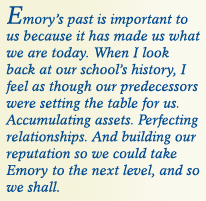 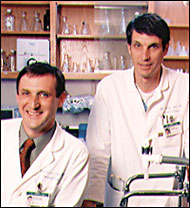 Drs. Christian Larsen and Thomas Pearson 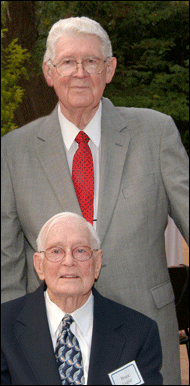 Drs. Bruce Logue (seated) and Willis Hurst (standing)  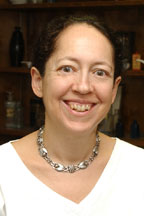 Dr. Barbara Stoll 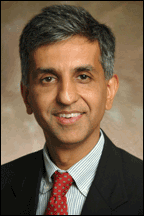 Dr. Sanjay Saini 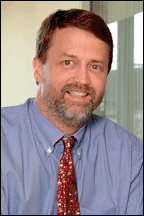 Dr. William Eley 
Dr. Wright Caughman |
Then and Now: 150 Years of Emory Medicine Today, on exactly the same spot, our new Emory Center for Clinical Training and Faculty Building at Grady Memorial Hospital cost precisely 1,000 times as much—$15 million—and is occupied by nearly 100 faculty members. In 1854, tuition was $105, with a $5 matriculation fee and a $10 fee for a dissecting ticket. This fee went directly to the anatomy demonstrator, since he had to procure the dissecting material at his own expense. The first dean was Dr. John Westmoreland, who faced severe financial problems. More than that, the Atlanta Medical College soon faced a Civil War. Classes were suspended in 1861, and in 1864 the building was to be burned like the rest of Atlanta by General Sherman. But it was saved by a trick conceived by a faculty member named Dr. Noel D’Alvigny. The building was being used as a hospital, and after the real patients were evacuated on the eve of the planned burning of the building, Dr. D’Alvigny plied the hospital attendants with whiskey to pose as patients in the hospital. He then complained to the Union officer in charge that wounded men were going to be burned without being given a chance to escape. After viewing the bogus patients, who were moaning and begging for help, the officer gave Dr. D’Alvigny until dawn to have the men removed. By the time dawn rolled around, the Union Army had begun its March to the Sea, and the Atlanta Medical College building was saved. Thirty years later, in 1892, Grady Memorial Hospital opened. It was built as a tribute to Atlanta newspaper editor Henry Grady and began as a 100-bed hospital dedicated to caring for the indigent of the South. The site on Butler Street was chosen because the medical school was across the street. Thus began our long history of affiliation with and staffing of Grady. We can fast forward to 1913 when the Flexner Report, combined with pressure from the American Medical Association and the Association of American Medical Colleges, convinced the Atlanta College of Physicians and Surgeons and the Atlanta School of Medicine to consolidate back into the Atlanta Medical College and consider affiliation with a university. In 1915, Coca-Cola founder Asa Candler donated the land and $1 million to establish Emory University in Atlanta. Emory College then moved from Oxford, Georgia, to Atlanta, and Emory University School of Medicine was formed that same year when Atlanta Medical College transferred its holdings to the university, which pledged $250,000 to endow the school. Fast forward again to 1937, when Coca-Cola leader Robert Woodruff began to display his growing interest in medicine at Emory by donating $50,000 to form a cancer clinic named for his grandfather (Robert Winship), known today as the Winship Cancer Institute. Over the years, generous donations by Mr. Woodruff and the Woodruff family of foundations have been key to the development of the School of Medicine and the Woodruff Health Sciences Center. From 1915 on, nine deans have served Emory School of Medicine, with tenures ranging from Dr. Gene Stead’s one year to Dr. Arthur Richardson’s 23 years. Each contributed to the development of our mission. For many years, Grady Hospital was  much better known than Emory School of Medicine.
much better known than Emory School of Medicine.Let me briefly recap some of the major milestones in our school’s history. After Emory School of Medicine was established in 1915, the Anatomy and Physiology Buildings opened in 1917. Emory University Hospital, formerly Wesley Memorial Hospital, moved from downtown Atlanta to campus in 1922. Yerkes Regional Primate Center was established in Florida in 1930 and acquired by Emory in 1956. It moved to Atlanta in 1965 and is now called Yerkes National Primate Research Center. The Robert Winship Memorial Clinic for cancer treatment and research was established in 1937. The Emory Clinic was founded in 1953, Wesley Woods was formed in 1954, and Henrietta Egleston Hospital for Children moved to our campus in 1959. Construction of the Centers of Disease Control (CDC) next to our campus was completed in 1960. The Robert W. Woodruff Medical Center (later renamed The Robert W. Woodruff Health Sciences Center) was established in 1966. The Veterans Affairs (VA) Medical Center, affiliated with Emory since 1946, was built in 1967. In the mid-1980s, Mr. Woodruff died at age 95. Also, during this decade, the School of Medicine began to emphasize its research mission in a very serious way. Emory Healthcare was formed in 1997, and the following year, Egleston and Scottish Rite hospitals merged to become Children’s Healthcare of Atlanta. Today, in 2004, we are beginning to focus on medical education reform.  This chronology represents bricks and mortar. I have not talked about some of the landmark contributions of our faculty, and I want to mention a couple of high points. In 1962, Dr. Charles Hatcher performed Georgia’s first blue baby operation using open heart surgery. In 1963, Dr. Hamilton Holmes became Emory’s first African-American medical student. The following year, Dr. Asa Yancey became Emory’s first African-American faculty member. In 1980, Dr. Andreas Gruentzig, who developed angioplasty and performed the first procedure in Switzerland in 1977, joined the Emory faculty. He continued to develop the procedure here and changed forever the treatment of atherosclerosis. In 1992, Dr. Mahlon DeLong and his colleagues performed the first pallidotomy on a patient with Parkinson’s disease. During the mid-1990s, Emory patented the compound 3TC, invented by Drs. Dennis Liotta and Raymond Schinazi. This compound and a second known as FTC hold immense promise for the treatment of HIV and also substantial financial benefit to the university. And in 2003, Drs. Christian Larsen and Thomas Pearson performed Georgia’s first islet cell transplant. Emory’s past is important to us because it has made us what we are today. When I look back at our school’s history, I feel as though our predecessors were setting the table for us. Accumulating assets. Perfecting relationships. And building our reputation so we could take Emory to the next level, and so we shall. Two of Emory’s giants, Drs. Bruce Logue and Willis Hurst, clearly helped put cardiology on the map here. The school has grown enormously in size and reputation. It has changed from being a good medical school in the Southeast to one that commands national attention, and from being a school where clinical medicine and teaching were at the forefront to one that has also become research intensive. So in this 150th anniversary year, we plan to celebrate our past and our current accomplishments and also have some fun. We are planning a number of academic and social events that we hope will advance our recognition and reputation and raise money to support our missions and our future. The School of Medicine will host fund-raisers involving alumni and grateful patients in Boston, New York, Washington, Miami, and Orlando, with another for alumni and friends in Atlanta in December. A seminar series is being planned for the spring, with a 150th anniversary donor’s dinner on May 13, 2005. A 150th anniversary faculty party will follow the next day, and I hope all of you will be able to participate in that. 2003-2004: Another Stellar Year  As
for the Class of 2008, we received more than 5,000 applications and interviewed
764 of those applicants. The individuals we admitted had an average undergraduate
GPA of 3.7 and an average MCAT score of 33-plus. We continue to admit
very good students, and we are still a very popular school. As
for the Class of 2008, we received more than 5,000 applications and interviewed
764 of those applicants. The individuals we admitted had an average undergraduate
GPA of 3.7 and an average MCAT score of 33-plus. We continue to admit
very good students, and we are still a very popular school. If we look at gender diversity, this class happens to be 55% male and 45% female. That is a reversal from last year’s class, which was majority female. But what I expect to see over the years is approximately 50% men and 50% women in our classes. The Class of 2006 did extremely well on the USMLE, Step 1. The Emory mean score was 228, whereas the national mean was 216. About 90% of our students scored above the national mean, and about 30% of our students scored above the 95th percentile. Additionally, the Class of 2004 did well on Step 2 of the USMLE, with an average mean of 228 compared with the national mean of 218. I also want to acknowledge the Graduate Division of Biological and Biomedical Sciences (GDBBS) in the Graduate School of Arts and Sciences. This division has 297 faculty members, many of whom come from the medical school, and 376 students. I want to single out Interim Dean Dr. Bryan Noe for the great job he is doing in sustaining GDBBS and in helping recruit outstanding students along with the rest of our faculty. The total number of faculty in the School of Medicine is large and growing larger. We now have 1,660 full-time faculty members. The last two years have been good ones for recruitment and promotion of female and minority faculty. Almost a third of our faculty—31%—are female, and more than a fourth—28%—are minority. Of our senior faculty, 17% are female, and 13% are minority. Over the past two years, 34 female and 29 minority faculty members were appointed or promoted to senior ranks, comprising in each year 26% and 23% of the newly appointed or promoted senior faculty. Our goal is to retain and recruit more female and minority faculty members, mentor them, and move them into the senior ranks, where they  can be role models and leaders for all of us.
can be role models and leaders for all of us. The quality of our school depends heavily on the quality of our faculty. This past year, a number of newly recruited or existing faculty have received endowed chairs or professorships. These are honorific, but they also provide important financial support that frees up faculty time, often from the clinical enterprise, to pursue teaching and research interests. Dr. Barbara Stoll is our new Chair of the Department of Pediatrics and Medical Director of Children’s at Egleston. She has been a faculty member here since 1986 and has served very ably as Interim Chair over the past year. She is a renowned neonatologist and researcher focused on neonatal infections, immune development of the fetus and newborn, child survival, and the use of epidemiologic studies in neonatal and perinatal medicine. Dr. Stoll is also the first holder of the George W. Brumley Jr. Chair in Pediatrics, and we’re very pleased about that. Last fall, Dr. William Casarella, Chair of the Department of Radiology for 24 years, announced his decision to step down from that role. He has done a remarkable job of building radiology into one of the nation’s top 20 departments and being one of the thought leaders in the School of Medicine. He has served and will continue to serve as Executive Associate Dean for Clinical Affairs at Grady, where he already has provided thousands of hours of effort on our behalf, helping us navigate through those complicated waters. Just a few weeks ago, Dr. Sanjay Saini joined us as our new Chair of Radiology. Dr. Saini enjoyed a distinguished career at Massachusetts General Hospital, where he served as Director of Computed Tomography and Vice Chair of Radiology for Health System Affairs. He was also the Director and Chief Operating Officer of Partners Radiology. Dr. Saini received his medical degree from Tufts and his master’s degree in management from MIT. We are very pleased to have him here. In addition to filling his post, we are conducting two chair searches in Biochemistry and Radiation Oncology. A series of transitions have taken place in the Dean’s Office. A few months ago, Dr. Jack Shulman, who was Executive Associate Dean for Medical Education and Student Affairs, announced his desire to cut back his duties. He served in the Dean’s Office for 14 years and has done a magnificent job. He is chiefly responsible for the very high quality of our current curriculum and the vigor with which it is taught to our students. Dr. Shulman also has helped innumerable students through the sometimes-difficult transitions in their academic and personal lives. And no one is more loved by the students than he. Luckily, he is going to stay on as a part-time senior adviser for curriculum development,  which I will describe more fully later in this report.
which I will describe more fully later in this report.To assume Jack’s position, I have appointed Dr. William Eley as Executive Associate Dean for Medical Education and Student Affairs. Dr. Eley has done that job for the past nine months and acquitted himself very well. As Dr. Eley stepped up from his prior position as Associate Dean for Admissions, I have asked Dr. Ira Schwartz to assume that responsibility. Dr. Eley and Dr. Schwartz now have even bigger plates, but I know they are going to be successful in managing them. Last but not least, I want to mention Dr. Wright Caughman, current Chair of Dermatology, who also has been named as Director of The Emory Clinic, and Dr. Ira Horowitz, who is Associate Director. I have also named Dr. Caughman as Executive Associate Dean for Clinical Affairs for The Emory Clinic. Dr. Caughman and Dr. Horowitz have bigger jobs, but I am absolutely confident of their success. We are fortunate to have this enormous amount of depth and talent here at Emory. Sadly, we are losing two important people from the Dean’s Office. One is Dr. Robert Rich, Executive Associate Dean for Research and Strategic Initiatives. This news is bittersweet. Bob is leaving us to become Senior Vice President and Dean of Medicine at the University of Alabama at Birmingham (UAB). He has played a critical role in helping implement our first research strategic plan and in helping formulate our most recent research strategic plan. He has done a marvelous job over the past six years—our funding from the National Institutes of Health has more than doubled. We wish Bob every success at his new institution. Second, I would like to mention Dr. Susan Rich, who has been Assistant Dean for Postdoctoral Education. Not surprisingly, she is also leaving to go to UAB. Susan has had great success in creating, launching, and guiding the Office of Postdoctoral Education. She has improved the lives of our postdoctoral fellows through the development of new benefits and hiring policies, career development programs, and mentoring. She is going to become the Associate Dean for Life Sciences at UAB, where  she is going to establish a graduate program similar to our GDBBS. We
will miss Susan and wish her well.
she is going to establish a graduate program similar to our GDBBS. We
will miss Susan and wish her well.I would like to mention our faculty for several reasons. One, of course, is the extraordinarily high quality of our senior faculty appointments over the past year. The other is that the president of Emory University has a faculty appointment in the School of Medicine. We could not be prouder to have President James Wagner on our faculty in Biomedical Engineering. I also want to say a special word of thanks to the Faculty Committee on Promotions and Appointments. They are some of the hardest-working individuals on what I consider to be one of the most important committees in our school. They oversee new appointments and judge the promotions of all faculty from the associate professor level up. All deserve great thanks for the hard work they do on our behalf. Last, special congratulations are in order for the seven individuals who won the 2004 Dean’s Excellence in Teaching Awards. They are among our very best teachers. They were nominated by their colleagues as well as by students and residents, and they should serve as an example to all of us. All are clearly talented and dedicated to teaching. They have many other duties, both in research labs and in the clinics. They deserve our deepest admiration. How are we doing in research? For total federal research grants and contracts in 2002–2003 (the latest figures available), we are ranked 17th, just ahead of UAB and just behind the University of Michigan. We should also look at our National Institutes of Health (NIH) data. From 1996 to 2003, we have enjoyed a nearly threefold increase in research dollars, from $55 million to $158 million. This is the second-fastest rate of growth among the top 25 US schools of medicine. If you look at our research growth in another way by comparing Emory to our benchmark medical schools—11 schools that include Hopkins (No. 1), Penn (No. 3), Yale (No. 5), and Baylor (No. 7)—we are last on the list. But if you rank these schools by rate of growth, we come in second, just behind Vanderbilt, with an average annual compound growth rate of 16.2% in our research enterprise, which is really remarkable. This is a tribute to all of our investigators as well as the strategic plans that have guided our growth since 1996. I want to give kudos to a number of departments that are ranked in the top 20 by NIH in their respective disciplines. Special notice should be paid to Emergency Medicine, currently ranked No. 2 in the nation, as well as Microbiology & Immunology, also ranked No. 2. These rankings reflect our talent and our abilities. In FY 2003, the NIH awarded a total of $10.8 billion to 121 US medical schools. The top 25 medical schools garnered more than half (56% or $6.1 billion) of that amount, while the other 96 schools received less than half (44% or $4.7 billion). Fortunately, we are among the top 25 schools and want to stay there. Furthermore, we want to push our enterprise and grow our research until we at least reach top-10 status. |
 |
|
|
|
|